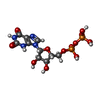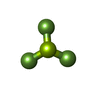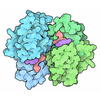+ Open data
Open data
- Basic information
Basic information
| Entry | Database: PDB / ID: 8dhb | |||||||||||||||
|---|---|---|---|---|---|---|---|---|---|---|---|---|---|---|---|---|
| Title | Active FLCN GAP complex | |||||||||||||||
 Components Components |
| |||||||||||||||
 Keywords Keywords | SIGNALING PROTEIN / FLCN / Rag-Ragulator / GTPase Activating Protein / mTORC1 signaling | |||||||||||||||
| Function / homology |  Function and homology information Function and homology informationasparagine transport / L-asparagine transmembrane transporter activity / sterol sensor activity / negative regulation of cell proliferation involved in kidney development / cell proliferation involved in kidney development / negative regulation of post-translational protein modification / L-arginine transmembrane transporter activity / L-arginine transmembrane transport / regulation of cholesterol import / positive regulation of protein localization to lysosome ...asparagine transport / L-asparagine transmembrane transporter activity / sterol sensor activity / negative regulation of cell proliferation involved in kidney development / cell proliferation involved in kidney development / negative regulation of post-translational protein modification / L-arginine transmembrane transporter activity / L-arginine transmembrane transport / regulation of cholesterol import / positive regulation of protein localization to lysosome / regulation of cell-substrate junction organization / Gtr1-Gtr2 GTPase complex / regulation of cholesterol efflux / L-glutamine transmembrane transporter activity / glutamine transport / regulation of Ras protein signal transduction / FNIP-folliculin RagC/D GAP / Ragulator complex / negative regulation of brown fat cell differentiation / protein localization to cell junction / amino acid transmembrane transport / L-leucine transmembrane transporter activity / L-amino acid transmembrane transporter activity / regulation of TORC1 signaling / regulation of pro-B cell differentiation / negative regulation of lysosome organization / protein localization to lysosome / regulation of TOR signaling / fibroblast migration / MTOR signalling / lysosome localization / Amino acids regulate mTORC1 / Energy dependent regulation of mTOR by LKB1-AMPK / endosome organization / ATPase inhibitor activity / TORC1 signaling / amino acid transmembrane transporter activity / cell-cell junction assembly / negative regulation of glycolytic process / negative regulation of TOR signaling / kinase activator activity / protein localization to membrane / arginine binding / negative regulation of cold-induced thermogenesis / endosomal transport / azurophil granule membrane / lysosome organization / cholesterol binding / small GTPase-mediated signal transduction / Macroautophagy / negative regulation of Rho protein signal transduction / regulation of cell size / positive regulation of transforming growth factor beta receptor signaling pathway / RHOJ GTPase cycle / RHOQ GTPase cycle / TOR signaling / glutathione transferase / mTORC1-mediated signalling / hemopoiesis / CDC42 GTPase cycle / RHOH GTPase cycle / tertiary granule membrane / glutathione transferase activity / RHOG GTPase cycle / ficolin-1-rich granule membrane / regulation of receptor recycling / enzyme inhibitor activity / RAC2 GTPase cycle / RAC3 GTPase cycle / positive regulation of TOR signaling / enzyme-substrate adaptor activity / response to amino acid / cellular response to nutrient levels / specific granule membrane / positive regulation of intrinsic apoptotic signaling pathway / energy homeostasis / protein-membrane adaptor activity / ERK1 and ERK2 cascade / RAC1 GTPase cycle / glutathione metabolic process / positive regulation of TORC1 signaling / positive regulation of autophagy / negative regulation of phosphatidylinositol 3-kinase/protein kinase B signal transduction / intrinsic apoptotic signaling pathway / GTPase activator activity / negative regulation of autophagy / transforming growth factor beta receptor signaling pathway / cellular response to amino acid starvation / RNA splicing / viral genome replication / guanyl-nucleotide exchange factor activity / cholesterol homeostasis / cellular response to starvation / epithelial cell proliferation / Regulation of PTEN gene transcription / tumor necrosis factor-mediated signaling pathway / positive regulation of interleukin-8 production / TP53 Regulates Metabolic Genes / cellular response to amino acid stimulus / positive regulation of protein-containing complex assembly Similarity search - Function | |||||||||||||||
| Biological species |  Homo sapiens (human) Homo sapiens (human) | |||||||||||||||
| Method | ELECTRON MICROSCOPY / single particle reconstruction / cryo EM / Resolution: 3.53 Å | |||||||||||||||
 Authors Authors | Jansen, R.M. / Hurley, J.H. | |||||||||||||||
| Funding support |  United States, United States,  Italy, 4items Italy, 4items
| |||||||||||||||
 Citation Citation |  Journal: Sci Adv / Year: 2022 Journal: Sci Adv / Year: 2022Title: Structural basis for FLCN RagC GAP activation in MiT-TFE substrate-selective mTORC1 regulation. Authors: Rachel M Jansen / Roberta Peruzzo / Simon A Fromm / Adam L Yokom / Roberto Zoncu / James H Hurley /  Abstract: The mechanistic target of rapamycin complex 1 (mTORC1) regulates cell growth and catabolism in response to nutrients through phosphorylation of key substrates. The tumor suppressor folliculin (FLCN) ...The mechanistic target of rapamycin complex 1 (mTORC1) regulates cell growth and catabolism in response to nutrients through phosphorylation of key substrates. The tumor suppressor folliculin (FLCN) is a RagC/D guanosine triphosphatase (GTPase)-activating protein (GAP) that regulates mTORC1 phosphorylation of MiT-TFE transcription factors, controlling lysosome biogenesis and autophagy. We determined the cryo-electron microscopy structure of the active FLCN complex (AFC) containing FLCN, FNIP2, the N-terminal tail of SLC38A9, the RagA:RagC GTPase dimer, and the Ragulator scaffold. Relative to the inactive lysosomal FLCN complex structure, FLCN reorients by 90°, breaks contact with RagA, and makes previously unseen contacts with RagC that position its Arg finger for catalysis. Disruption of the AFC-specific interfaces of FLCN and FNIP2 with RagC eliminated GAP activity and led to nuclear retention of TFE3, with no effect on mTORC1 substrates S6K or 4E-BP1. The structure provides a basis for regulation of an mTORC1 substrate-specific pathway and a roadmap to discover MiT-TFE family selective mTORC1 antagonists. | |||||||||||||||
| History |
|
- Structure visualization
Structure visualization
| Structure viewer | Molecule:  Molmil Molmil Jmol/JSmol Jmol/JSmol |
|---|
- Downloads & links
Downloads & links
- Download
Download
| PDBx/mmCIF format |  8dhb.cif.gz 8dhb.cif.gz | 393.9 KB | Display |  PDBx/mmCIF format PDBx/mmCIF format |
|---|---|---|---|---|
| PDB format |  pdb8dhb.ent.gz pdb8dhb.ent.gz | 288.2 KB | Display |  PDB format PDB format |
| PDBx/mmJSON format |  8dhb.json.gz 8dhb.json.gz | Tree view |  PDBx/mmJSON format PDBx/mmJSON format | |
| Others |  Other downloads Other downloads |
-Validation report
| Summary document |  8dhb_validation.pdf.gz 8dhb_validation.pdf.gz | 1.8 MB | Display |  wwPDB validaton report wwPDB validaton report |
|---|---|---|---|---|
| Full document |  8dhb_full_validation.pdf.gz 8dhb_full_validation.pdf.gz | 1.8 MB | Display | |
| Data in XML |  8dhb_validation.xml.gz 8dhb_validation.xml.gz | 73.3 KB | Display | |
| Data in CIF |  8dhb_validation.cif.gz 8dhb_validation.cif.gz | 108.5 KB | Display | |
| Arichive directory |  https://data.pdbj.org/pub/pdb/validation_reports/dh/8dhb https://data.pdbj.org/pub/pdb/validation_reports/dh/8dhb ftp://data.pdbj.org/pub/pdb/validation_reports/dh/8dhb ftp://data.pdbj.org/pub/pdb/validation_reports/dh/8dhb | HTTPS FTP |
-Related structure data
| Related structure data |  27435MC M: map data used to model this data C: citing same article ( |
|---|---|
| Similar structure data | Similarity search - Function & homology  F&H Search F&H Search |
- Links
Links
- Assembly
Assembly
| Deposited unit | 
|
|---|---|
| 1 |
|
- Components
Components
-Ras-related GTP-binding protein ... , 2 types, 2 molecules AB
| #1: Protein | Mass: 44384.004 Da / Num. of mol.: 1 Source method: isolated from a genetically manipulated source Source: (gene. exp.)  Homo sapiens (human) / Gene: RRAGC / Production host: Homo sapiens (human) / Gene: RRAGC / Production host:  Homo sapiens (human) Homo sapiens (human)References: UniProt: Q9HB90, Hydrolases; Acting on acid anhydrides; Acting on GTP to facilitate cellular and subcellular movement |
|---|---|
| #2: Protein | Mass: 39362.078 Da / Num. of mol.: 1 Source method: isolated from a genetically manipulated source Source: (gene. exp.)  Homo sapiens (human) / Gene: RRAGA / Production host: Homo sapiens (human) / Gene: RRAGA / Production host:  |
-Ragulator complex protein ... , 5 types, 5 molecules CDEFG
| #3: Protein | Mass: 18325.350 Da / Num. of mol.: 1 Source method: isolated from a genetically manipulated source Source: (gene. exp.)  Homo sapiens (human) / Gene: LAMTOR1, C11orf59, PDRO, PP7157 / Production host: Homo sapiens (human) / Gene: LAMTOR1, C11orf59, PDRO, PP7157 / Production host:  |
|---|---|
| #4: Protein | Mass: 13645.579 Da / Num. of mol.: 1 Source method: isolated from a genetically manipulated source Source: (gene. exp.)  Homo sapiens (human) / Gene: LAMTOR2, MAPBPIP, ROBLD3, HSPC003 / Production host: Homo sapiens (human) / Gene: LAMTOR2, MAPBPIP, ROBLD3, HSPC003 / Production host:  |
| #5: Protein | Mass: 13637.678 Da / Num. of mol.: 1 Source method: isolated from a genetically manipulated source Source: (gene. exp.)  Homo sapiens (human) / Gene: LAMTOR3, MAP2K1IP1, MAPKSP1, PRO2783 / Production host: Homo sapiens (human) / Gene: LAMTOR3, MAP2K1IP1, MAPKSP1, PRO2783 / Production host:  |
| #6: Protein | Mass: 10753.236 Da / Num. of mol.: 1 Source method: isolated from a genetically manipulated source Source: (gene. exp.)  Homo sapiens (human) / Gene: LAMTOR4, C7orf59 / Production host: Homo sapiens (human) / Gene: LAMTOR4, C7orf59 / Production host:  Homo sapiens (human) / References: UniProt: Q0VGL1 Homo sapiens (human) / References: UniProt: Q0VGL1 |
| #7: Protein | Mass: 18178.520 Da / Num. of mol.: 1 Source method: isolated from a genetically manipulated source Source: (gene. exp.)  Homo sapiens (human) / Gene: LAMTOR5, HBXIP, hCG_40252 / Production host: Homo sapiens (human) / Gene: LAMTOR5, HBXIP, hCG_40252 / Production host:  Homo sapiens (human) / References: UniProt: A0A0C4DGV4 Homo sapiens (human) / References: UniProt: A0A0C4DGV4 |
-Protein , 3 types, 3 molecules HIJ
| #8: Protein | Mass: 41000.711 Da / Num. of mol.: 1 Source method: isolated from a genetically manipulated source Source: (gene. exp.)  Homo sapiens (human) / Gene: SLC38A9, URLC11 / Production host: Homo sapiens (human) / Gene: SLC38A9, URLC11 / Production host:  Homo sapiens (human) Homo sapiens (human)References: UniProt: P08515, UniProt: Q8NBW4, glutathione transferase |
|---|---|
| #9: Protein | Mass: 149865.641 Da / Num. of mol.: 1 Source method: isolated from a genetically manipulated source Source: (gene. exp.)  Homo sapiens (human) / Gene: FNIP2, FNIPL, KIAA1450, MAPO1 / Production host: Homo sapiens (human) / Gene: FNIP2, FNIPL, KIAA1450, MAPO1 / Production host:  Homo sapiens (human) / References: UniProt: Q9P278 Homo sapiens (human) / References: UniProt: Q9P278 |
| #10: Protein | Mass: 69143.070 Da / Num. of mol.: 1 Source method: isolated from a genetically manipulated source Source: (gene. exp.)  Homo sapiens (human) / Gene: FLCN, BHD / Production host: Homo sapiens (human) / Gene: FLCN, BHD / Production host:  Homo sapiens (human) / References: UniProt: Q8NFG4 Homo sapiens (human) / References: UniProt: Q8NFG4 |
-Non-polymers , 3 types, 3 molecules 




| #11: Chemical | ChemComp-CZC / [( |
|---|---|
| #12: Chemical | ChemComp-BEF / |
| #13: Chemical | ChemComp-GDP / |
-Details
| Has ligand of interest | Y |
|---|---|
| Has protein modification | Y |
-Experimental details
-Experiment
| Experiment | Method: ELECTRON MICROSCOPY |
|---|---|
| EM experiment | Aggregation state: PARTICLE / 3D reconstruction method: single particle reconstruction |
- Sample preparation
Sample preparation
| Component |
| ||||||||||||||||||||||||
|---|---|---|---|---|---|---|---|---|---|---|---|---|---|---|---|---|---|---|---|---|---|---|---|---|---|
| Molecular weight |
| ||||||||||||||||||||||||
| Source (natural) |
| ||||||||||||||||||||||||
| Source (recombinant) |
| ||||||||||||||||||||||||
| Buffer solution | pH: 7.4 | ||||||||||||||||||||||||
| Specimen | Conc.: 1 mg/ml / Embedding applied: NO / Shadowing applied: NO / Staining applied: NO / Vitrification applied: YES | ||||||||||||||||||||||||
| Vitrification | Cryogen name: ETHANE / Humidity: 100 % / Chamber temperature: 277.15 K |
- Electron microscopy imaging
Electron microscopy imaging
| Experimental equipment |  Model: Titan Krios / Image courtesy: FEI Company |
|---|---|
| Microscopy | Model: FEI TITAN KRIOS |
| Electron gun | Electron source:  FIELD EMISSION GUN / Accelerating voltage: 300 kV / Illumination mode: FLOOD BEAM FIELD EMISSION GUN / Accelerating voltage: 300 kV / Illumination mode: FLOOD BEAM |
| Electron lens | Mode: BRIGHT FIELD / Nominal defocus max: 2000 nm / Nominal defocus min: 1000 nm |
| Image recording | Electron dose: 50 e/Å2 / Film or detector model: GATAN K3 (6k x 4k) |
- Processing
Processing
| CTF correction | Type: PHASE FLIPPING AND AMPLITUDE CORRECTION |
|---|---|
| 3D reconstruction | Resolution: 3.53 Å / Resolution method: FSC 0.143 CUT-OFF / Num. of particles: 177018 / Symmetry type: POINT |
 Movie
Movie Controller
Controller



 PDBj
PDBj













